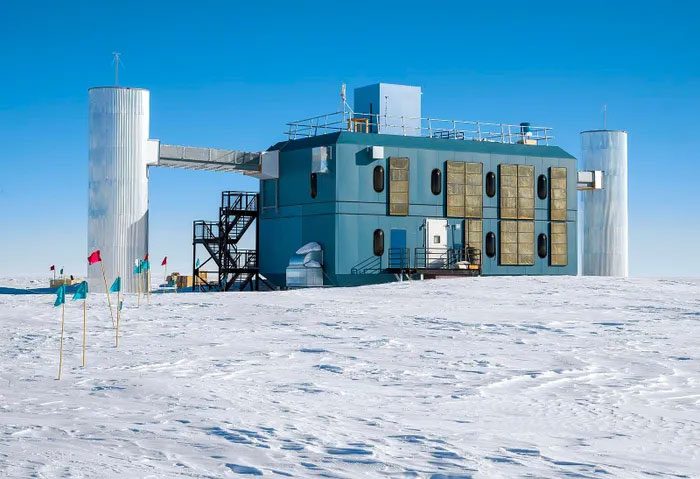In reality, throughout your life, only a few atoms in your body may come into contact with primordial neutrinos. This is because atoms, although small, are “hollow” with significant distances between their nuclei, allowing neutrinos, which are electrically neutral, to easily pass through the body without causing any collisions.
Neutrinos generated by objects like black holes typically possess more energy than the primordial neutrinos that drift through space. Although they are much rarer, these high-energy neutrinos are more likely to collide with something and create signals that physicists can detect. However, to discover them, neutrino physicists have had to design large-scale experiments.
IceCube, one such experiment, recorded a type of neutrino from the universe that has exceptionally rare energy in a study published in April of this year. These high-energy neutrinos often “disguise” themselves as other, more common types of neutrinos. For the first time, Professor of Physics and Astronomy at Pennsylvania State University Doug Cowen and his colleagues have detected them from nearly a decade’s worth of collected data.
Their presence brings researchers one step closer to unraveling the mystery of how high-energy particles like neutrinos are produced.
IceCube Observatory

The IceCube Neutrino Observatory conducts large-scale neutrino experiments.
The IceCube Neutrino Observatory is where large-scale neutrino experiments are conducted. The observatory collects signals from about 5,000 sensors that have monitored tons of ice beneath Antarctica for over a decade. The choice of location in Antarctica was to avoid human-made atmospheric pollution, enabling the most effective reception of cosmic rays.
When a neutrino collides with an atom in the ice, it creates a point of light that the sensors record. As a result, IceCube has detected neutrinos generated in various locations, such as the Earth’s atmosphere, the center of the Milky Way, and black holes in galaxies light-years away from us. However, the tau neutrino, a type of neutrino with special energy, has eluded IceCube—until now.
Neutrinos come in three different types, which physicists refer to as “flavors” or “types” (electron neutrino, muon neutrino, or tau neutrino). Each flavor leaves a unique signature on detectors like IceCube.
When a neutrino collides with another particle, it typically produces a charged particle corresponding to its flavor. Muon neutrinos produce muons, electron neutrinos produce electrons, and tau neutrinos produce tau particles.
Muon neutrinos have the most distinctive signature, so scientists in the IceCube collaboration have first looked for those naturally. A muon emitted from a muon neutrino collision travels through hundreds of meters of ice, creating a detectable long light trail before it decays. This trail allows researchers to trace the origin of the neutrino.
Next, the research team observed electron neutrinos, where their interactions create a nearly spherical bright spot. The electron produced from a collision with an electron neutrino never decays and collides with every ice particle it encounters. This interaction leaves a bright spot that expands spherically.
Since the direction of electron neutrinos is very difficult to discern visually, IceCube physicists have applied techniques to determine where electron neutrinos may have originated. These techniques use complex computational resources and adjust millions of parameters to separate the neutrino signal from all known background signals.
The third flavor of neutrino, tau neutrinos, is the most elusive “chameleon.” A tau neutrino may appear as a light trail, while the next neutrino may manifest as a bright spot. The tau particle produced in the collision will travel for an incredibly short amount of time before decaying, and upon decay, it often creates a spherical bright spot.
These tau neutrinos create two bright spheres: one initial sphere from their collision producing the tau particle and another sphere where the tau particle itself decays. Most of the time, the tau particle decays after traveling only a very short distance, causing the two bright spheres to overlap so much that they cannot be distinguished from one another.
However, at higher energy levels, the emitted tau particles can travel dozens of meters, causing the two bright spheres to separate. Physicists equipped with advanced techniques are capable of seeing this—an endeavor described as finding a needle in a haystack.
As neutrinos move through IceCube, a very small fraction of them will interact with atoms in the ice and create light that the sensors record. In the video, the spheres represent individual sensors, with the size of each sphere proportional to the amount of light it detects. The colors indicate the relative arrival time of the light, following the colors of the rainbow, where red arrives first and violet arrives last.
With these computational tools, the research team has extracted seven prominent tau neutrinos from approximately ten years of data. These tau neutrinos possess more energy than the strongest particle accelerators on Earth, indicating that they must originate from cosmic sources, such as black holes.
As IceCube and other neutrino experiments gather more data and scientists increasingly differentiate between the three types of neutrinos, researchers will ultimately be able to infer how neutrinos originating from black holes are produced.
High-energy tau neutrinos (including muon neutrinos) are typically far fewer than the common neutrinos stemming from the Big Bang. However, in the vastness of space, there is still much to aid scientists in their search for the strongest neutrino sources in the universe.


















































